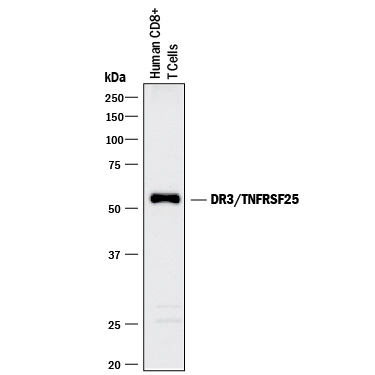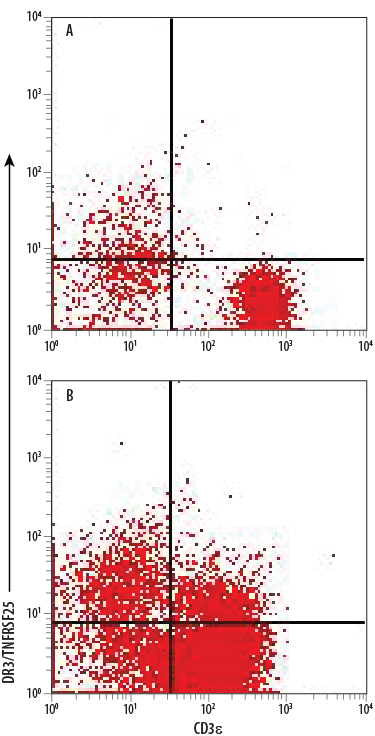Human/Mouse DR3/TNFRSF25 Antibody Summary
Gln25-Phe201
Accession # Q93038
Applications
Please Note: Optimal dilutions should be determined by each laboratory for each application. General Protocols are available in the Technical Information section on our website.
Scientific Data
 View Larger
View Larger
Detection of Human DR3/TNFRSF25 by Western Blot. Western blot shows lysates of human CD8+T cells. PVDF membrane was probed with 2 µg/mL of Mouse Anti-Human/Mouse DR3/TNFRSF25 Monoclonal Antibody (Catalog # MAB943) followed by HRP-conjugated Anti-Mouse IgG Secondary Antibody (Catalog # HAF018). A specific band was detected for DR3/TNFRSF25 at approximately 55 kDa (as indicated). This experiment was conducted under reducing conditions and using Immunoblot Buffer Group 1.
 View Larger
View Larger
Detection of DR3/TNFRSF25 in Mouse Splenocytes by Flow Cytometry. Mouse splenocytes either (A) untreated or (B) treated with PMA and Calcium Ionomycin for 24 hours were stained with Mouse Anti-Human DR3/TNFRSF25 Monoclonal Antibody (Catalog # MAB943) followed by Allophycocyanin-conjugated Anti-Mouse IgG Secondary Antibody (Catalog # F0101B) and Rat Anti-Mouse CD3 PE-conjugated Monoclonal Antibody (Catalog # FAB4841P). Quadrant markers were set based on control antibody staining (Catalog # MAB002).
 View Larger
View Larger
Detection of DR3/TNFRSF25 in Human PBMCs by Flow Cytometry. Human peripheral blood mononuclear cells (PBMCs) either (A) untreated or (B) treated with PMA and Calcium Ionomycin for 24 hours were stained with Mouse Anti-Human DR3/TNFRSF25 Monoclonal Antibody (Catalog # MAB943) followed by Phycoerythrin-conjugated Anti-Mouse IgG Secondary Antibody (Catalog # F0102B) and Mouse Anti-Human CD3e APC-conjugated Monoclonal Antibody (Catalog # FAB100A). Quadrant markers were set based on control antibody staining (Catalog # MAB002).
Reconstitution Calculator
Preparation and Storage
- 12 months from date of receipt, -20 to -70 °C as supplied.
- 1 month, 2 to 8 °C under sterile conditions after reconstitution.
- 6 months, -20 to -70 °C under sterile conditions after reconstitution.
Background: DR3/TNFRSF25
Death receptor 3 (DR3), also known as lymphocyte-associated receptor of death (LARD), WSL-1, APO3, TRAMP and TR3, is a glycoprotein belonging to the TNF receptor superfamily (TNFRSF) (1 - 5). DR3 was formerly designated TNFRSF12 when it was thought to be a receptor for TWEAK/TNFSF12 (6). However, work disavowed the DR3:TWEAK interaction and DR3 is now designated TNFRSF 25 (7). By alternative splicing, at least 11 distinct human DR3 transcripts encoding secreted or type I membrane proteins exist (7). The human DR3 isoform 1 cDNA encodes a 417 amino acid residue (aa) transmembrane precursor with a 24 aa signal peptide, a 175 aa extracellular domain containing four cysteine-rich repeats and two potential N-glycosylation sites, a 21 aa transmembrane region and a 195 aa cytoplasmic region with one death domain. DR3 is one of six within the TNF R superfamily that contains a death domain in its cytooplasmic region. It is most closely related to TNF R1 and FAS/CD95, sharing 29% and 23% aa sequence identity, respectively. DR3 is expressed primarily in tissues enriched in lymphocytes. Whereas naïve B and T cells express multiple truncated DR3 isoforms but not the transmembrane isoform 1, upon T cell activation, expression of the transmembrane DR3 isoform 1 predominates. TL1A/VEGI, a TNF superfamily ligand, has been shown to bind and activate DR3 (8). Depending on the cell context, ligation of DR3 by TL1A can trigger one of two signaling pathways. On primary T cells, TL1A induces NF-kappa-B activation and a costimulatory signal to increase IL-2 responsiveness and the secretion of proinflammatory cytokines. However, in a tumor cell line, TF-1, TL1A has been shown to induce caspase activity and apoptosis. In DR3-null mice, an impairment of negative selection and anti-CD3-mediated thymocyte apoptosis is observed.
- Chinnaiyan, A.M. et al. (1996) Science 274:990.
- Kitson, J. et al. (1996) Nature 384:372.
- Bodmer, J-L. et al. (1997) Immunity 6:79.
- Screaton, G.R. et al. (1997) Proc. Nat. Acad. Sci. USA 94:4615.
- Marsters, S.A. et al. (1996) Curr. Biol. 6:1669.
- Marsters, S.A. et al. (1998) Curr. Biol. 8:525.
- Kaptein, A. et al. (2000) FEBS Lett. 485:135.
- Migone, T-S. et al. (2002) Immunity 16:479.
Product Datasheets
Citations for Human/Mouse DR3/TNFRSF25 Antibody
R&D Systems personnel manually curate a database that contains references using R&D Systems products. The data collected includes not only links to publications in PubMed, but also provides information about sample types, species, and experimental conditions.
2
Citations: Showing 1 - 2
Filter your results:
Filter by:
-
Survival advantages conferred to colon cancer cells by E-selectin-induced activation of the PI3K-NFkappaB survival axis downstream of Death receptor-3.
Authors: Porquet N, Poirier A, Houle F, Pin AL, Gout S, Tremblay PL, Paquet ER, Klinck R, Auger FA, Huot J
BMC Cancer, 2011-07-01;11(0):285.
Species: Human
Sample Types: Whole Cells
Applications: Neutralization -
Soluble decoy receptor 3 induces angiogenesis by neutralization of TL1A, a cytokine belonging to tumor necrosis factor superfamily and exhibiting angiostatic action.
Authors: Yang CR, Ho FM, Su WL
Cancer Res., 2004-02-01;64(3):1122-9.
Species: Human
Sample Types: Cell Lysates
Applications: Western Blot
FAQs
No product specific FAQs exist for this product, however you may
View all Antibody FAQsReviews for Human/Mouse DR3/TNFRSF25 Antibody
There are currently no reviews for this product. Be the first to review Human/Mouse DR3/TNFRSF25 Antibody and earn rewards!
Have you used Human/Mouse DR3/TNFRSF25 Antibody?
Submit a review and receive an Amazon gift card.
$25/€18/£15/$25CAN/¥75 Yuan/¥2500 Yen for a review with an image
$10/€7/£6/$10 CAD/¥70 Yuan/¥1110 Yen for a review without an image



